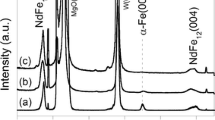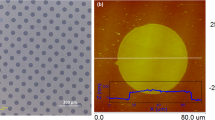Abstract
The thermodynamically crystallographic phase of Co at ambient conditions is hexagonal-close-packed. However, it has been found that given a crystallographic support from a suitable substrate, the high-temperature face-centered-cubic phase can be stabilized in thin films. We performed cross-sectional high-resolution transmission electron microscopy on a Si substrate/Si buffer/Co/CoO/Cu\(_{41}\)Ni\(_{59}\)/Nb/Cu\(_{41}\)Ni\(_{59}\)/Si-cap heterostructure (all layer thicknesses in the nanometer range). We analyzed lattice spacings and angles of the Co layer and neighbouring layers. While in the present study, there is no obvious support for an fcc structure by the amorphous Si buffer and the CoO (spinel structure), only an fcc phase of the Co layer (of about 5 nm thickness) is in agreement with the obtained results. However, the detailed mechanism of phase stabilization remains unresolved.

Similar content being viewed by others
References
J. Giber, R. Drube, V. Dose, Appl. Phys. A 52, 167 (1991)
Q. Meng, S. Guo, X. Zhuo, S. Veintemillas-Verdaguer, J. Alloy Compd. 580, 187 (2013)
J.E. Fisher, Thin Solid Films 5, 53 (1970)
H.L. Gaigher, N.G. van der Berg, Electrochim. Acta 21, 45 (1976)
H. Li, B.P. Tonner, Surface Sci. 237, 141 (1990)
C.M. Schneider, P. Bressler, P. Schuster, J. Kirschner, J.J. de Miguel, R. Miranda, S. Ferrer, Vacuum 41, 503 (1990)
J.R. Cerdá, P.L. de Andres, A. Cebollada, R. Miranda, E. Navas, P. Schuster, C.M. Schneider, J. Kirschner, J. Phys. Condens. Matter 5, 2055 (1993)
C. Rath, J.E. Prieto, S. Müller, R. Miranda, K. Heinz, Phys. Rev. B 55, 10791 (1997)
C. Chappert, P. Bruno, J. Appl. Phys. 64, 5736 (1988)
J.L. Beaujour, W. Chen, A.D. Kent, J.Z. Sun, J. Appl. Phys. 99, 08N503 (2006)
C.H. Lee, H. He, F.J. Lamelas, W. Vavra, C. Uher, R. Clarke, Phys. Rev. B 42, 1066(R) (1990)
W. Wernsdorfer, C. Thirion, N. Demoncy, H. Pascard, D. Mailly, J. Magn. Magn. Mater. 242–245, 132 (2002)
D. Lenk, R. Morari, V.I. Zdravkov, A.Ullrich, G.Obermeier, C.Müller, A.S. Sidorenko, H.A. Krug von Nidda, S. Horn, L.R. Tagirov, R. Tidecks, Full-Switching FSF-Type Superconducting Spin-Triplet Magnetic Random Access Memory Element (accepted for publication in Phys. Rev. B, 2017)
L. Gragnaniello, S. Agnoli, G. Parteder, A. Barolo, F. Bondino, F. Allegretti, S. Surnev, G. Granozzi, F.P. Netzer, Surf. Sci. 604, 2002 (2010)
V.I. Zdravkov, D. Lenk, R. Morari, A. Ullrich, G. Obermeier, C. Müller, H.A. Krug von Nidda, A.S. Sidorenko, S. Horn, R. Tidecks, L.R. Tagirov, Appl. Phys. Lett. 103, 062604 (2013)
J.M. Kehrle, The Fulde-Ferrell Larkin-Ovchinnikov Like State in Bilayers and Trilayers of Superconducting and Ferromagnetic Thin Films (Doctoral Thesis, Universität Augsburg, 2012)
J. Kehrle, V.I. Zdravkov, G. Obermeier, J. Garcia-Garcia, A. Ullrich, C. Müller, R. Morari, A.S. Sidorenko, S. Horn, L.R. Tagirov, R. Tidecks, Ann. Phys. 524, 37 (2012)
E.A. Owen, D.M. Jones, Proc. Phys. Soc. B 67, 456 (1954)
C. Kittel, Einführung in die Festkörperphysik, 8th edn. (R. Oldenbourg Verlag, München, 1989)
P.J. van der Zaag, J.A. Borchers, Antiferromagnetic-Ferromagnetic Oxide Multilayers: Fe3O4-Based Systems as a Model, in Magnetic Properties of Antiferromagnetic Oxide Materials, ed. by L. Duò, M. Finazzi, F. Ciccacci (Wiley-VCH, Weinheim, 2010)
L. Vegard, Z. Phys. 5, 17 (1921)
L. Vegard, Z. Kristallogr. 67, 239 (1928)
A.R. Denton, N.W. Ashcroft, Phys. Rev. A 43, 3161 (1991)
W.P. Davey, Phys. Rev. 25, 753 (1925)
C.M. Singal, T.P. Das, Phys. Rev. B 16, 5068 (1977)
C.A.F. Vaz, E.I. Altman, V.E. Henrich, Phys. Rev. B 81, 104428 (2010)
A. Kelly, K.M. Knowles, Crystallography and Crystal Defects, 2nd edn. (Wiley, Chichester, 2006)
Acknowledgements
The authors are grateful to S. Heidemeyer, B. Knoblich, and W. Reiber for TEM sample preparation.
This work was supported by the Deutsche Forschungsgemeinschaft (DFG) under Grant No. HO 955/9-1.
The partial support by STCU (Grant No. 5982, A.S.S. and R.M.) is acknowledged.
Author information
Authors and Affiliations
Corresponding author
Appendix
Appendix
1.1 Crystal structure and lattice constants of the used materials
For the evaluation of the TEM image, knowledge of the lattice constants and the crystallographic structure is essential. The literature values used for the evaluation are given in Table 2.
The lattice constant used for fcc Co (3.543 Å) has been obtained by Cerdá et al. [7] for thin films on Cu substrates at room temperature (they report this value to be in excellent agreement to 3.548 Å , which is an average value of the data reported in Table 1 of the work of Owen et al. [18], obtained by X-ray powder diffraction).
The mixed valence compound Co\(_3\)O\(_4\) crystallizes in a normal spinel structure (see p. 503 of Kittel’s book [19], Fig. 7.1 of the work of van der Zaag and Borchers [20]) with Co\(^{2+}\) and Co\(^{3+}\) ions occupying tetrahedral and octahedral sites, respectively [14], whereas CoO exhibits a rock-salt structure (see p.33 of Kittel’s book [19], Fig. 4.4 of the work of van der Zaag and Borchers [20]), in which all Co\(^{2+}\) ions are octahedrally coordinated to oxygen [14].
Both Cu and Ni crystallize in an fcc structure, so the disordered Cu\(_{41}\)Ni\(_{59}\) alloy formed is also expected to exhibit fcc structure. According to Vegard’s rule [21, 22] (see the work of Denton and Ashcroft [23] for a critical discussion), an estimation of the resulting lattice constant of the alloy can be obtained by linear interpolation between the lattice constant of Cu and Ni (3.597 Å and 3.499 Å, respectively [24]), yielding a value of 3.539 Å for Cu\(_{41}\)Ni\(_{59}\).
The lattice spacing and the included angle for any given pair of layers can be calculated from the standard formulas (see, e.g., Appendix 3 of the book of Kelly and Knowles [27]).
Rights and permissions
About this article
Cite this article
Lenk, D., Ullrich, A., Zdravkov, V.I. et al. Observation of an fcc–Co nanolayer grown between CoO and amorphous Si. Appl. Phys. A 123, 760 (2017). https://doi.org/10.1007/s00339-017-1375-6
Received:
Accepted:
Published:
DOI: https://doi.org/10.1007/s00339-017-1375-6




